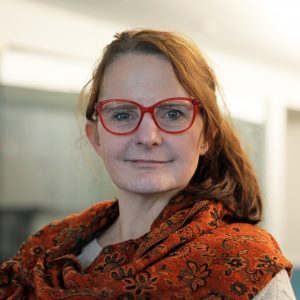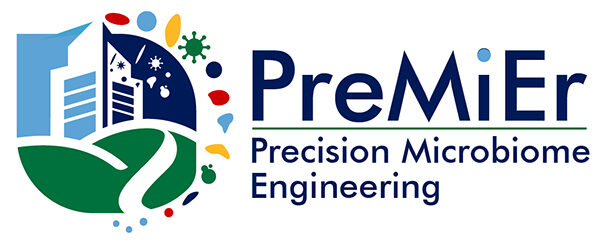
At NSF center, NC State to Lead Research on Societal and Ethical Implications of Emerging Technologies

Conceptual illustration of bacterial microbiome (Adobe Stock)
September 7, 2022 | Nash Dunn
Inside homes, schools and other indoor spaces where we spend most of our lives, we’re surrounded by a host of microorganisms. However, not much is known about how these microbial communities form and function — nor how they interact with the human body.
In an effort to better understand and improve the health of our built environments, an interdisciplinary team of researchers seeks to develop diagnostic tools and engineering approaches to help reduce the number of harmful microbes while encouraging beneficial ones. This work is at the forefront of the National Science Foundation Engineering Research Center for Precision Microbiome Engineering (PreMiEr). Announced in August, the center is led by Duke University with partners at four other North Carolina universities – including NC State.
NC State will play a key role in the center’s work by examining the societal, ethical and policy implications of microbiome engineering advancements. Jennifer Kuzma, the Goodnight-NCGSK Foundation Distinguished Professor in the School of Public and International Affairs and co-director of the Genetic Engineering and Society Center, serves as associate director of PreMiEr and will head efforts to explore and consider public attitudes, risks, and multi-disciplinary perspectives related to the research.
We caught up with Kuzma to learn more about the work and why it’s needed.
What perspective will your team bring to this project?

Jennifer Kuzma
Part of this center’s work will involve the potential manipulation of the microbiome. In other words, either engineering the combination of bacteria that are in a built environment to make it a healthier place for people to live and work, or manipulating the microbiome in the built environment through genetic engineering. Both of those approaches come with some societal hesitation or concerns that we need to consider.
Our social and ethical implications team will work with scientists and engineers from the very beginning, and there will be bidirectional learning. Not only will we learn more about their challenges and their work, but they’ll respond to some of the ideas we have about the societal implications, concerns and hopes for the technology. Because if you start with the public in mind at the beginning, you’re more likely to be successful at the end.
What are examples of societal or ethical issues related to microbiome engineering?
Privacy is a big one. You wouldn’t necessarily think of it, but when you walk into a building, you share the microbiome with that space. Your microbiome is shared with other people and with the physical environment. There’s a continual kind of flux of microorganisms, and researchers have been able to correlate signatures of certain individuals in built environments. And so there are concerns that people might be able to identify individuals by their microbiome signature — kind of like a footprint.
Of course, another big one is the safety of the actual engineering of the microbiome. You want to make sure that you’re increasing the benefits to human health and decreasing the risks, not doing the opposite. So that’s another big component of what our core will be looking at: safety and risk analysis. We all have different tolerances for risk. And we also think that concepts of safety are different based on cultural and individual values. So we’re going to be studying those components, not only doing risk analysis but also looking at the societal dimensions of risk and safety — and what they mean to different communities.
There are also components of ownership of the microbiome. So, who owns the microbiome or the technology? We share it with other people in the building, so patents and intellectual property ownership of this kind of technology is a complex question.
An Interdisciplinary Approach
With backgrounds ranging from biomolecular engineering to fungal microbiomes, researchers from five NC State colleges are contributing their expertise to the National Science Foundation Engineering Research Center for Precision Microbiome Engineering.
- Benjamin Callahan, assistant professor in the College of Veterinary Medicine, will serve as a member of the project’s data analytics team.
- Nathan Crook, assistant professor in the College of Engineering, will serve on a team developing tools for targeting the delivery and removal of desired genetic features.
- Kevin Garcia, assistant professor in the College of Agriculture and Life Sciences, will serve on a team studying fungal microbiomes.
- Jennifer Kuzma, the Goodnight-NCGSK Foundation Distinguished Professor in the College of Humanities and Social Sciences and co-director of the Genetic Engineering and Society Center, will serve as principal investigator for NC State, co-PI for the center, and lead of the social and implications team.
- Yihui Zhou, associate professor in the College of Sciences, will serve as co-lead of the predictive microbiome modeling team.
How will your team engage and integrate public attitudes into this research?
Part of our work will involve monitoring and tracking, at a national level, public opinion about engineering the microbiome in built environments — and identifying public concerns and hopes for the technology. So we’ll be doing regular quantitative work and surveys, as well as qualitative focus groups and engagement exercises.
It’s going to be most important to engage historically marginalized, underrepresented and indigenous groups because using their microbiome or manipulating their built environments can be exploitative. You want to make sure that you’re not doing this in a vacuum to communities, but you’re doing it for communities — especially those that have been hurt in the past by either technology, or poor environmental conditions, or poor public health settings.
The diversity of viewpoints also makes the science better, too. It’s important for ethical reasons, but it’s also important for quality. When you have more and diverse types of people looking at a problem, really wonderful things can happen from that expanded expertise.
